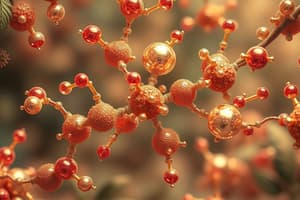Podcast
Questions and Answers
What was the Picture Perfect case about?
What was the Picture Perfect case about?
It was about how a textile worker could identify a stain on an old dress and how it could be removed.
What bio-related topics does the Picture Perfect case involve?
What bio-related topics does the Picture Perfect case involve?
Starch/how it's removed, enzymes, cellulose.
What type of macromolecule are starch and cellulose?
What type of macromolecule are starch and cellulose?
Polysaccharides.
What monomer is found in starch and cellulose?
What monomer is found in starch and cellulose?
Contrast the structure/function of starch with those of cellulose in plant cells.
Contrast the structure/function of starch with those of cellulose in plant cells.
What is an enzyme?
What is an enzyme?
What happens to starch molecules when amylase acts upon it?
What happens to starch molecules when amylase acts upon it?
Why can amylase break down amylose easier than it can break down amylopectin?
Why can amylase break down amylose easier than it can break down amylopectin?
Why didn't the textile worker have to worry about the amylase cleaning solution damaging the dress?
Why didn't the textile worker have to worry about the amylase cleaning solution damaging the dress?
When iodine was added to a test tube with starch and amylase, why did the iodine turn blue?
When iodine was added to a test tube with starch and amylase, why did the iodine turn blue?
What was the purpose of adding iodine to the test tubes containing starch and amylase?
What was the purpose of adding iodine to the test tubes containing starch and amylase?
What did the Benedict's solution test for in the results of the lab?
What did the Benedict's solution test for in the results of the lab?
Which solution removed the most wallpaper in the wallpaper lab?
Which solution removed the most wallpaper in the wallpaper lab?
How did the most effective substance in the wallpaper lab remove the wallpaper paste?
How did the most effective substance in the wallpaper lab remove the wallpaper paste?
Explain the results seen with vinegar in the wallpaper lab.
Explain the results seen with vinegar in the wallpaper lab.
Why was it important for water to be used as a testable substance in the wallpaper lab?
Why was it important for water to be used as a testable substance in the wallpaper lab?
Flashcards are hidden until you start studying
Study Notes
Picture Perfect Lab Overview
- The Picture Perfect case involved a textile worker identifying and removing stains from an old dress using bio-related methods.
- Key biological topics include starch breakdown, enzyme action, and cellulose structure.
Polysaccharides
- Both starch and cellulose are classified as polysaccharides, which are complex carbohydrates made from multiple sugar units.
Monomer Units
- Glucose serves as the monomer for both starch and cellulose, forming the building blocks of these carbohydrates.
Structural Differences
- Starch consists of glucose monomers and serves primarily as a cellular fuel source.
- Cellulose exists in plant cell walls, where glucose monomers are linked differently, alternating orientations of the monomers' structures.
Enzyme Function
- Enzymes function as catalysts, facilitating chemical reactions without being consumed in the process.
Amylase Action on Starch
- Amylase cleaves starch molecules by breaking the bonds between glucose units, resulting in simpler sugars like maltose.
Amylose vs. Amylopectin Breakdown
- Amylose features a linear, unbranched structure, making it easier for amylase to degrade compared to the branched structure of amylopectin.
Effects of Amylase on Cellulose
- The textile worker was unconcerned about potential damage from amylase to the dress since cotton is primarily cellulose, which has beta-linkages that amylase cannot digest.
Iodine Test Results
- Iodine turned blue when added to a test tube containing starch due to the breakdown of starch by amylase prior to the test, indicating that starch had been digested.
Purpose of Iodine in the Experiment
- Iodine was added to test tubes to check for starch presence, with expectations of a blue reaction in tube 1A (starch present) and a lack of color change in tube 3A (no starch).
Benedict's Solution and Sugar Testing
- Positive results from Benedict's solution in tubes 2 and 4 indicated the presence of maltose, confirming that amylase hydrolyzed starch into simpler sugars.
Wallpaper Lab Results
- A 0.5% amylase solution effectively removed the most wallpaper, suggesting the wallpaper paste contained starch.
Mechanism of Wallpaper Removal
- The amylase solution disintegrated the bonds between starch monomers in the wallpaper paste, aiding in its removal.
Role of Vinegar in Results
- Vinegar's acidic properties hydrolyzed some starch, explaining its partial effectiveness (50% removal) in the wallpaper lab.
Control of Water in the Experiment
- Water was utilized as a control to demonstrate that it alone lacked the ability to break down starch, contrasting with the effects of the other solutions.
Studying That Suits You
Use AI to generate personalized quizzes and flashcards to suit your learning preferences.




